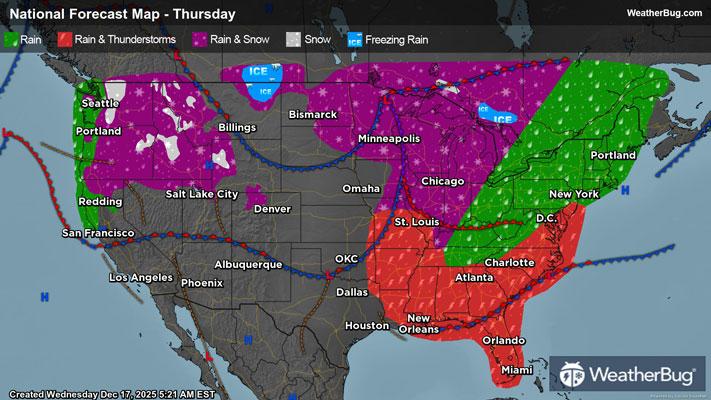Today's Weather Outlook

The relatively quiet weather pattern comes to an end today as an atmospheric river continues to drench the Northwest and a potent weather system moves across the eastern two-thirds of the nation.
A developing storm system will move from the northern Plains to the Great Lakes. This will also force a cold front across the nation’s midsection. Southerly winds ahead of the cold front will help to transfer a significant amount of moisture from the Gulf northward. Precipitation will be found throughout the eastern two-thirds of the U.S. as a result.
The northern Plains and Upper Mississippi Valley will likely just see light to moderate snow throughout the day, though the best chance will occur in the afternoon and evening. Rain will soak the Great Lakes into the evening, which will slowly mix with and transition over to snow tonight. Otherwise, rain and thunderstorms are likely across the rest of the Midwest, Deep South, Southeast, and Mid-Atlantic. Some rain could move into the Northeast late in the evening.
As if that wasn’t enough, it will be windy across the Plains and Midwest, especially in the morning and afternoon. Most spots will see wind gusts peak around 50 to 60 mph. However, locally higher winds of 70 to 80 mph will be possible. Be prepared for widespread power outages and downed trees. Blowing and drifting snow will also be a concern for the north-central U.S., with blizzard conditions creating treacherous driving conditions in some areas near the Canadian border.
Meanwhile, an atmospheric river event will persist across the Northwest, bringing a good surge of tropical moisture. There will also be a cold front that will advance eastward late in the evening. Precipitation will be found across the Northwest, northern California, and the northern Rockies.
Western Washington, western Oregon, and northern California will just see rain throughout the day, which could become moderate to heavy at times. The ground is already saturated from previous storms, so flooding will be a possibility, especially near rivers, creeks, streams, and other low-lying and flood-prone areas.
Light snow will overspread the northern Rockies in the morning, which will become moderate-to-heavy in the afternoon and evening. The interior Northwest will have a complicated setup, with snow or a rain/snow mix expected in the morning for eastern Washington and eastern Oregon, which will change over to rain for later in the day. There will likely be moderate to heavy snow throughout the northern Cascades in Washington for the entire day. Some freezing rain will also likely mix in at times.
Like the Plains and Midwest, winds will be increasing throughout the day in the Northwest. Peak wind gusts of 50 to 60 mph are likely here, though locally higher wind gusts cannot be ruled out in the mountains and higher elevations. Widespread power outages will also be likely here, as saturated soils and high winds will make trees and power lines more susceptible to being blown down.
Except for the north-central U.S., near to above normal temperatures will be dominant across the U.S. Unseasonably cold weather will be present in the north-central U.S.
The northern Plains and Upper Mississippi Valley will be the coldest spot in the nation. High temperatures will generally be in the single digits and teens, though areas closer to the U.S.-Canada border will see temperatures remain below zero. The tallest peaks in the Rockies will also report highs in the teens. Wind chill values will be even colder, so be sure to dress in plenty of layers.
The interior Northwest and the rest of the Rockies into the Great Lakes, Appalachian Spine, and Northeast will observe temperatures in the 20s, 30s, and a few lower 40s. Fifties are in store for the rest of the Northwest, northern California, and the Great Basin into the central Plains, Ohio, and Tennessee valleys, and the Mid-Atlantic will see highs in the 40s and 50s. Expect 60s and 70s for most of California into the Southwest, southern Plains, and Southeast, with isolated 80s for the Desert Southwest, far southern Texas, and a few spots in Florida.